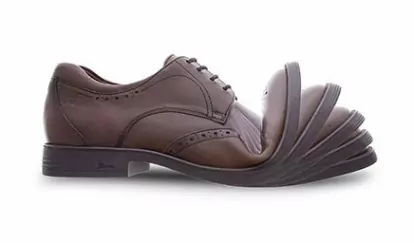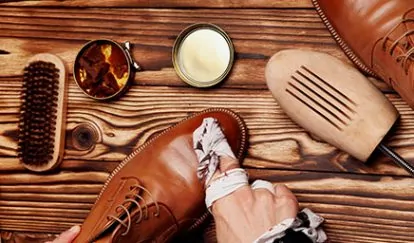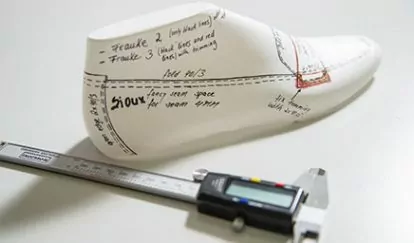SHOE CONSTRUCTION TECHNIQUES
Varying constructions for different types of shoes

Why are there so many different shoe models? The construction technique used by Sioux depends on what the shoe will be worn for and what the wearer requires from it. Because, ultimately, the shoe must have a perfect fit.
The so-called construction technique defines how the upper part of the shoe (shaft) and is connected with the sole.This is also known as assemblage.
The following parameters are critical in the choice of the construction technique: What should the shoe look like? How robust or flexible should the shoe be? Should the shoe be waterproof? A Sioux shoe combines look, craftsmanship, feel and material perfectly – these result in inimitable wearing properties. With dedication and passion to handcrafted detail, Sioux gives each shoe its distinctive character.
The art of shoemaking has accompanied mankind since time immemorial. It is a well-known fact that historians argue about which trade is the oldest in the world. We do not want to argue with other trades as to which industry was the first to be established. However, we insist that shoemaking goes back to very early times.
Hunters and gatherers originally wrapped skinned leather around their feet that was fixed by tendons or cords. Native Americans used this concept to develop the moccasins. Over the centuries, more construction techniques were developed – some of them have disappeared, some still exist. The most common thing concerning the construction technique is that the outsole and the upper are connected in a mechanical process – mostly by sewing or fastening with nails. Here it was all about the practical aspect. The ideal fit and maximum comfort were no issue at that time.
It was only in the course of the 19th century that new, more flexible construction techniques were developed (e.g. the California construction). These were followed by fixing methods that were established through new kinds of adhesives (AGO construction) in the 20th century.
All constructions have one in common: even today, shoemaking is a predominantly manual process that involves lots of craftmanship, a wealth of working steps and a wide range of materials and components.
Sacchetto
The shoe is comfortable and flexible as well soft and light on the inside – just like a mocassin. When the Sacchetto technique is employed, the soft leather used for the lining is sewn together like a small sack (Ital.: sacchetto) and integrated into the upper. The supple leather cocoons the foot like a glove.
California
The construction technique of these shoes, which hails from the USA state of the same name, ensures that the wearer is light on his feet. The special textile midsole gives the shoe its comfortable cushioning. On the outside, the California shoe is characterised by its striking California stripe: A stripe of leather from the upper that is stitched around the lower shaft.
San Crispino
The casual yet elegant men's shoe from Sioux. The San Crispino seam, which gives its name to this construction, has a sporty look and offers great flexibility. For the foot to be able to roll through softly in the shoe, the flexible insole should extend slightly above the last.
Moccasin
It is our favourite as it is so comfortable to wear. The soft leather fits perfectly like a glove over the entire foot. Moccasins were originally worn by Native Americans. The moccasin can justifiably be described as mankind's most natural and original shoe. It has been treasured since living memory because it fits the foot individually and can also be worn barefoot. No other shoe earns the attribute: man's second skin.
Shoe construction techniques
Why are there so many different shoe models? The construction technique used by Sioux depends on what the shoe will be worn for and what the wearer requires from it. Because, ultimately, the shoe must have a perfect fit.
Things you should consider when buying shoes
The following 10 tips will give you a practical guide and help you with your next shoe purchase. Besides the right shoe size and width, an optimal fit, skilful workmanship and the use of high-quality materials for the upper, lining and outsole are also important factors when it comes to quality and selection. We want you to stay feeling comfortable in your shoes for as long as possible.
Crepe sole
Learn more about what is undoubtedly the most natural form of comfort - everything about this Sioux speciality can be found here.
Labelling of materials
A question frequently asked by our customers is: “How can I be sure that the material used is really genuine leather?"
The history of footwear
More than 40,000 years ago, people developed a need to protect their feet against adverse external conditions. It took several centuries, however, until the fashionable and comfortable footwear that we are familiar with today became available.
Sioux hallgus protect
The combination of high-quality leather and our innovative Sioux-Tex climate membrane will give your feet that “feel-good” feeling: whilst moisture and vapour are quickly wicked away from the shoes, water from the outside has no chance of getting in, meaning your feet are always warm and dry.
Sioux natural move system
The combination of high-quality leather and our innovative Sioux-Tex climate membrane will give your feet that “feel-good” feeling: whilst moisture and vapour are quickly wicked away from the shoes, water from the outside has no chance of getting in, meaning your feet are always warm and dry.
SiouxTex
The combination of high-quality leather and our innovative Sioux-Tex climate membrane will give your feet that “feel-good” feeling: whilst moisture and vapour are quickly wicked away from the shoes, water from the outside has no chance of getting in, meaning your feet are always warm and dry.
Shoe lining
Consumers often only pay attention to whether they like a shoe and whether it fits well. What is inside the shoe should also be a decisive factor: the shoe lining is often underestimated when buying shoes, despite being a key factor when it comes to comfort and health. Below we will explain the various types of shoe lining, their uses and the importance of shoe lining when it comes to your well-being.
Shoe soles
Whether they are a lightweight and flexible, feature unique air-cushioning or have a timeless and elegant leather sole: it's the perfect join of the shoe upper and sole which is the finishing touch to each and every shoe.
Shoe size and fit
As the foot performs a rolling motion when walking, it bears your weight in various areas and thus changes shape in doing so. The hallmark of a perfect-fitting shoe is that the toes and the foot itself have enough space within the shoe throughout this rolling motion and that the heel experiences sufficient grip. When a shoe fits, the heel does not slip out of the back of the shoe, and the shoe sits so perfectly in the midfoot area that the foot is supported – and is unable to slip forwards – hence the shoe pinching.
Shoe leather
Choosing the leather is very easy when it comes to Sioux shoes: we only settle for the best.
Shoemaking
There are lots of steps involved in making a shoe. From developing the model in the first instance, to the stamping, sewing and putting the finishing touches to the shoe at the very end.
Grashopper
In the 1960s, the natural form moccasin was a revolution. Today, the cult shoe is more topical than ever as a pioneer in modern casual wear.
 DE
DE EN
EN FR
FR NL
NL




















